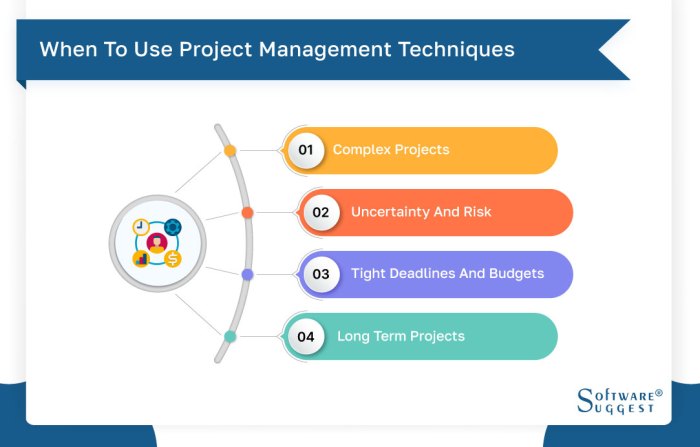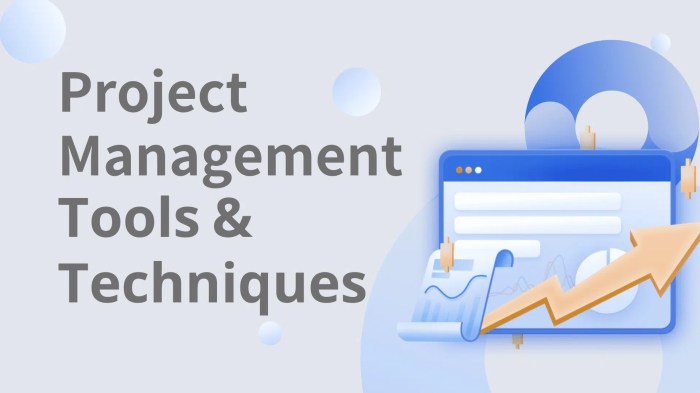Project Management Techniques takes center stage in this guide, offering a glimpse into the world of strategic organization and efficient execution. Get ready to dive into the realm of project management with a twist!
In the following sections, we’ll delve into traditional and agile project management techniques, explore essential tools and software, and uncover the secrets to success in project execution.
Overview of Project Management Techniques
Project management techniques are strategies and methodologies used to plan, execute, monitor, and control projects effectively. These techniques help ensure that projects are completed on time, within budget, and meet the desired objectives.
Commonly Used Project Management Techniques
- Agile Methodology: A flexible approach that focuses on iterative work cycles and continuous collaboration with stakeholders.
- Gantt Charts: Visual tools that Artikel project tasks, timelines, and dependencies to track progress.
- Critical Path Method (CPM): A technique that identifies the longest sequence of tasks in a project to determine the minimum time needed to complete it.
- PERT (Program Evaluation and Review Technique): A method to analyze and represent the tasks involved in completing a project.
Importance of Utilizing Project Management Techniques
Project management techniques are crucial in various industries as they help organizations achieve their goals efficiently. By using these techniques, companies can improve project outcomes, enhance team collaboration, reduce risks, and increase productivity. Implementing project management techniques also helps in effective resource allocation and cost management, leading to successful project delivery.
Traditional Project Management Techniques

Traditional project management techniques have been the cornerstone of project planning and execution for many years. These methodologies, such as Waterfall and Critical Path Method (CPM), have been widely used in various industries to ensure successful project delivery.
Waterfall Method
The Waterfall Method is a linear approach to project management where each phase must be completed before moving on to the next. This method is best suited for projects with clearly defined requirements and little to no expected changes during the project lifecycle. It provides a structured framework for project teams to follow, ensuring a systematic and organized approach to project completion.
Critical Path Method (CPM), Project Management Techniques
Critical Path Method (CPM) is a technique used to identify the longest sequence of dependent activities in a project. By focusing on these critical tasks, project managers can determine the minimum amount of time needed to complete a project. CPM helps in identifying potential delays and allows for better resource allocation to ensure project deadlines are met.
Comparison with Modern Approaches
Traditional project management techniques like Waterfall and CPM are often criticized for being rigid and less adaptive to changes. In contrast, modern approaches such as Agile and Scrum emphasize flexibility, collaboration, and continuous improvement. While traditional methods focus on detailed planning and sequential execution, modern approaches promote iterative development, customer feedback, and quick adaptation to change.
Case Study: Successful Application of Traditional Project Management
One notable example of successful application of traditional project management techniques is the construction of the Hoover Dam in the 1930s. The project followed a strict timeline and budget, with detailed planning and precise execution of tasks. The Critical Path Method was used to identify key activities and ensure timely completion of the dam. Despite numerous challenges, the project was completed ahead of schedule and within budget, showcasing the effectiveness of traditional project management methodologies in large-scale projects.
Agile Project Management Techniques
Agile project management is a dynamic approach that focuses on delivering value to customers through continuous iteration and collaboration. Its core principles include customer collaboration, responding to change, and delivering working solutions frequently.
Popular Agile Methodologies: Scrum and Kanban
Agile methodologies like Scrum and Kanban are widely used in project management for their effectiveness in promoting adaptability and flexibility. Here’s a brief overview of each:
- Scrum: Scrum is a framework that emphasizes teamwork, accountability, and iterative progress. It involves breaking down projects into small, manageable tasks that are completed in short cycles called sprints. Daily stand-up meetings and regular reviews help teams stay on track and adapt to changing requirements.
- Kanban: Kanban visualizes work as it moves through different stages of a process. Teams use a Kanban board to track tasks, identify bottlenecks, and optimize workflow. By limiting work in progress and focusing on continuous improvement, Kanban helps teams deliver value more efficiently.
Promoting Adaptability and Flexibility in Project Execution
Agile project management techniques promote adaptability and flexibility by encouraging collaboration, responding to change, and delivering value incrementally. By prioritizing customer needs and feedback, Agile teams can adjust their approach quickly to meet evolving requirements. This iterative process allows for continuous improvement and ensures that project outcomes align with stakeholder expectations.
Tools and Software for Project Management Techniques

When it comes to implementing project management techniques, having the right tools and software can make a world of difference in ensuring efficiency and success. Let’s explore some essential tools and software commonly used in project management.
Trello
Trello is a popular project management tool known for its user-friendly interface and visual approach to task management. It allows teams to create boards, lists, and cards to organize and prioritize tasks effectively. Some key features of Trello include:
- Drag-and-drop functionality for easy task management
- Collaboration tools for seamless communication within teams
- Integration with other apps and tools for enhanced productivity
Asana
Asana is another top choice for project management software, offering a range of features to streamline project planning and execution. Some benefits of using Asana include:
- Task assignment and tracking to monitor progress efficiently
- Customizable project views for different team members’ preferences
- Automated workflows to reduce manual tasks and improve efficiency
Microsoft Project
Microsoft Project is a robust project management tool that provides advanced features for planning, scheduling, and resource management. Utilizing Microsoft Project can offer benefits such as:
- Gantt charts for visual project timelines and dependencies
- Resource allocation tools to optimize team productivity
- Reporting and analytics for tracking project performance and identifying areas for improvement
Tips for Selecting the Right Tools
When choosing project management tools and software, it’s essential to consider the specific requirements of your project and the dynamics of your team. Here are some tips to help you select the right tools:
- Assess the features and capabilities of each tool to ensure they align with your project needs
- Consider the ease of use and learning curve for team members to adopt the software effectively
- Look for integration options with other tools your team already uses to streamline workflows
- Seek feedback from team members on their preferences and requirements to make an informed decision
